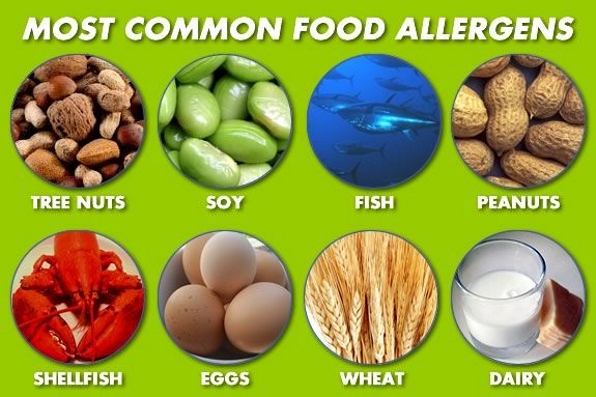…But the U.S. still lags behind other developed countries in its laws requiring food processors and manufacturers to identify foods that can cause potentially deadly allergic reactions in millions of its citizens. What’s taking it so long to move on protections?
 The 8 most common food allergens, as determined by the current U.S. Major Food
The 8 most common food allergens, as determined by the current U.S. Major Food
Allergens list. They just added sesame (seeds, oil, paste, whatever) as
a 9th allergen, to be fully declared on food labels by 2003.
We all know about the other items on the U.S. Major Food Allergens List: Milk, eggs, fish, shellfish, tree nuts, peanuts, wheat and soybeans. With the latest update, the List will soon include Sesame – which is found in many packaged foods, in either whole-seed, oil or paste form. This will come as a relief to about a million American families which have at least one member who is allergic to the popular Asian ingredient.
Sufferers and their advocates will explain that sesame allergies particularly to deal with, not in the least because it is one of a very few allergies that folks don’t grow out of by the time they reach adulthood – and it can develop any time in life, not necessarily showing up in childhood.
Sesame shows up in myriad Asian cuisines as well as in Middle eastern staples such as Tahini. Sesame oil is widely used to flavour a wide variety of prepared foods and is generally not identified on product labels.
Other countries way ahead
The original 2004 law governing the labeling of foods to identify potential allergens did not include Sesame or several other ingredients which are included on similar lists in other Western countries. The new FASTER Act signed into law this past Friday by U.S. President Joe Biden adds it to the list -but only after years of intensive research and lobbying by anti-allergy activists. Seems the food processing industry still enlists a powerful lobby.
What other potential foods appear on other countries’ allergen lists that the U.S. doesn’t yet name?
Canada includes mustard and sulphites in its 11-ingredient list.
Australia currently enforces a 10-ingredient allergen list and requires manufacturers and packagers to identify gluten-containing foods on their labels.
The UK’s list enumerates 14 foods that must be declared on food labels as allergens.
Officials haven’t missed the point
U.S. health and safety officials haven’t missed the point. The new FASTER law includes provisions for the Secretary of Health and Human Services to compile a detailed report on food allergies within the next 18 months. That report should list all work that federal government agencies are doing on then spectrum of food allergies, the prevalence of food allergies, treatments and prevention methods.
The report should document any work the federal government does related to a spectrum of food allergy issues, including research into the prevalence of food allergies, treatment options, and possible prevention methods. The law also calls for establishment of a new regulatory process to keep an eye on all foods with an eye to determining what the next major allergen may be – and the ones after that.
My take
It makes sense. Alas! Even as old, familiar allergens such as Peanuts are beginning to yield to new treatments and preventive measures (see photo, top of page), it seems that more foods are lining up for recognition as major allergens in the U.S.
Considering that a lot of the foods we eat come from the U.S., I’m comforted that any foods imported into Canada must be labeled according to Canadian regulations…
~ Maggie J.

